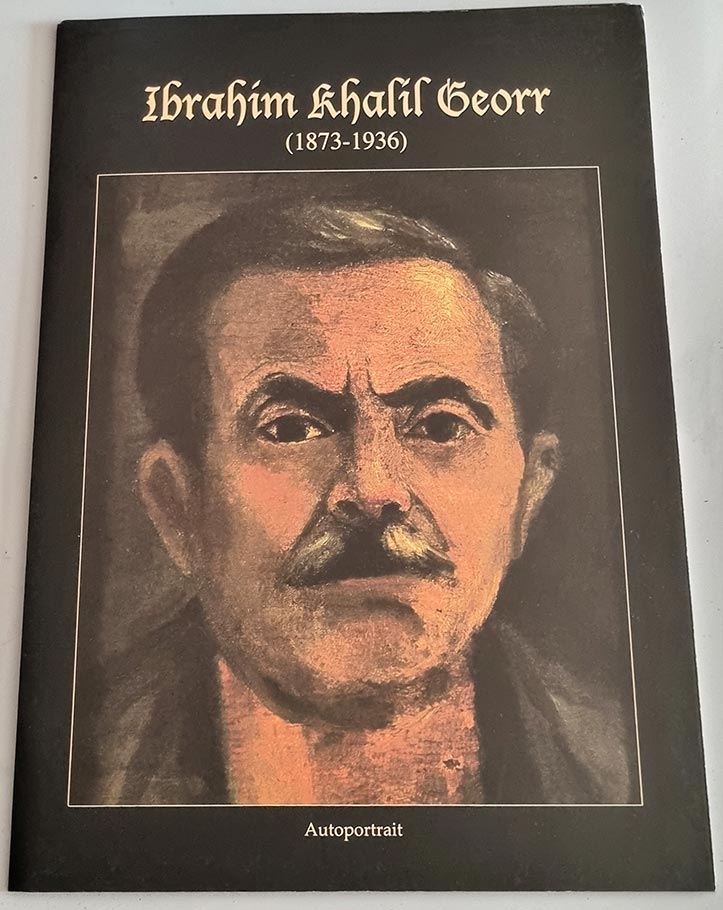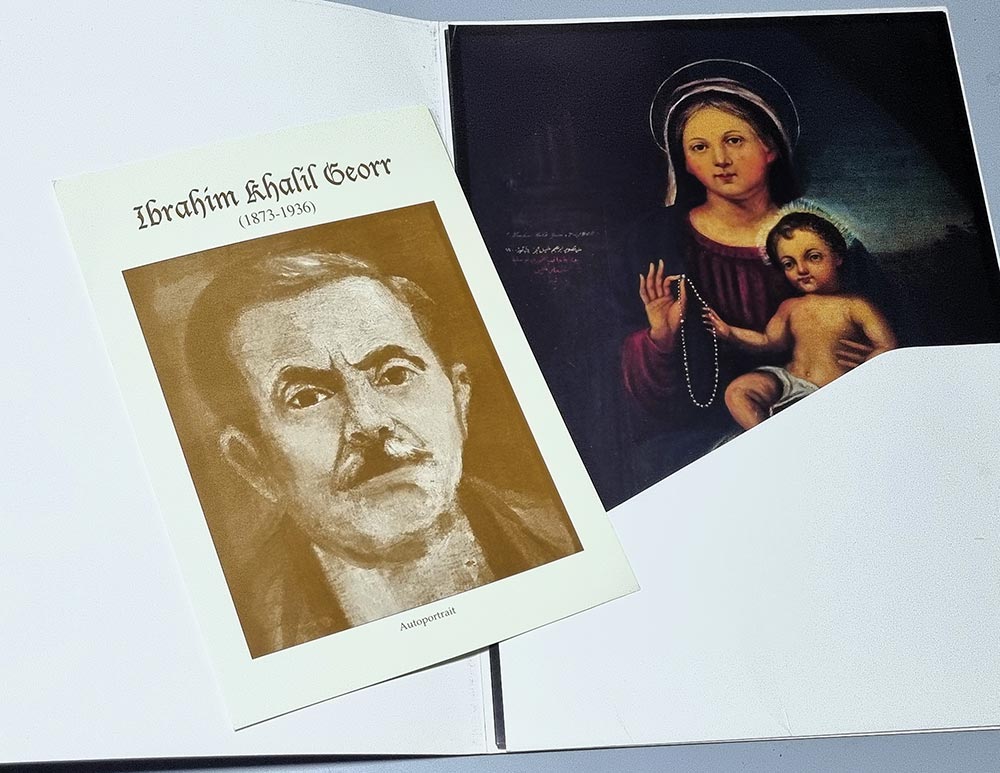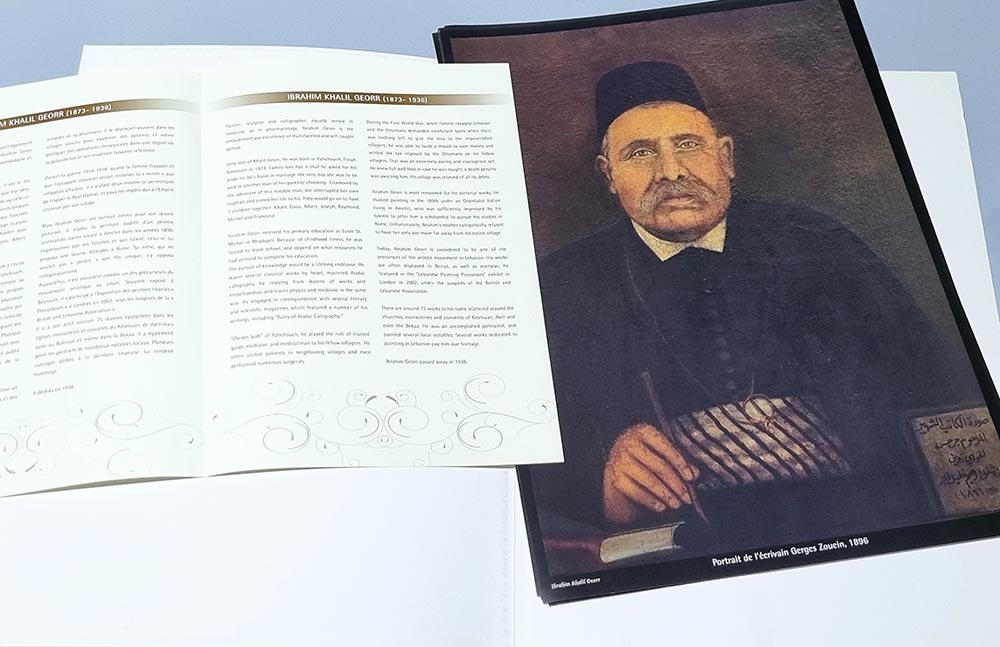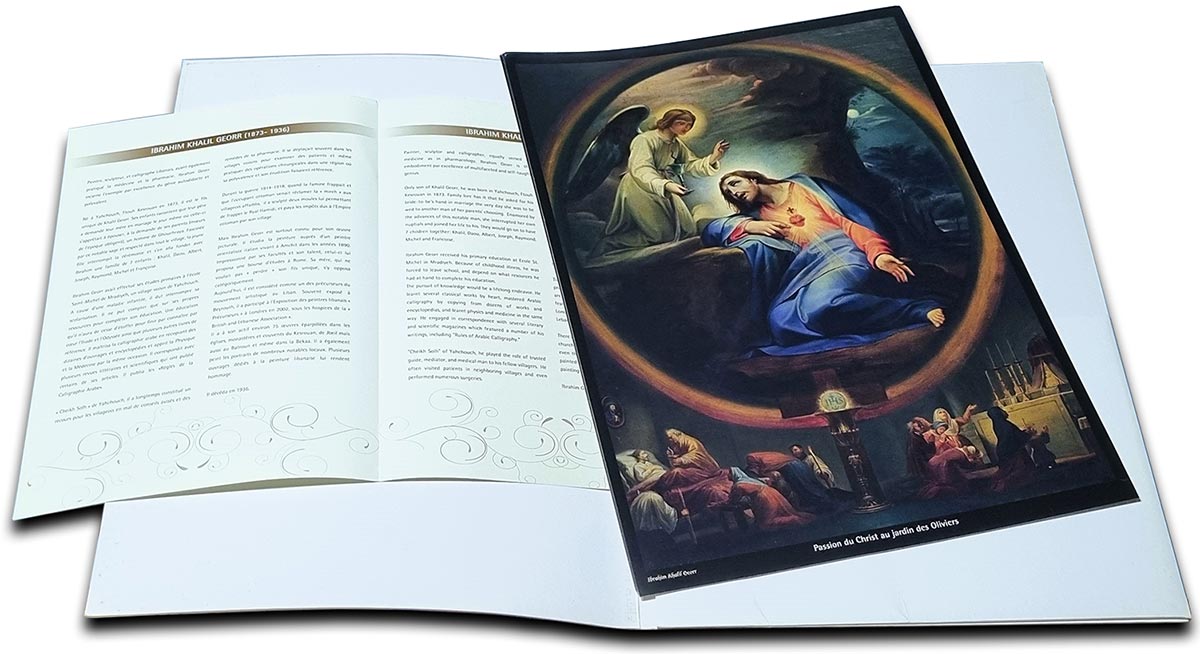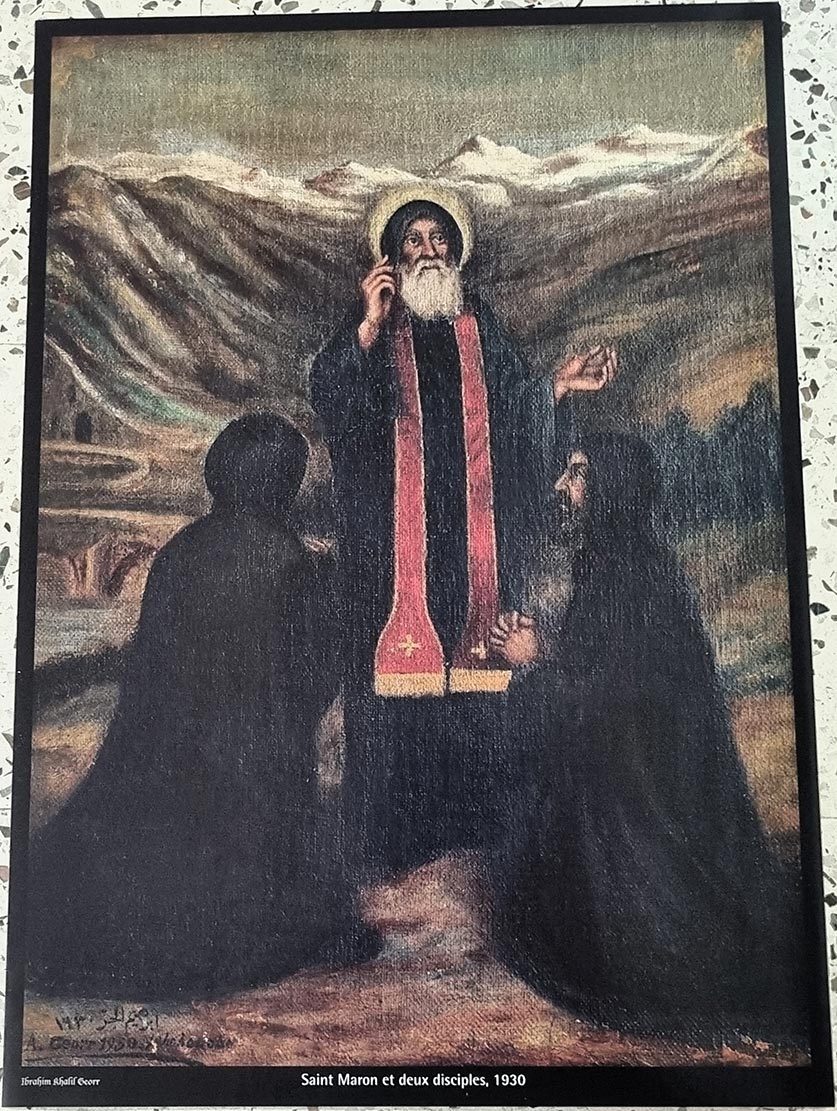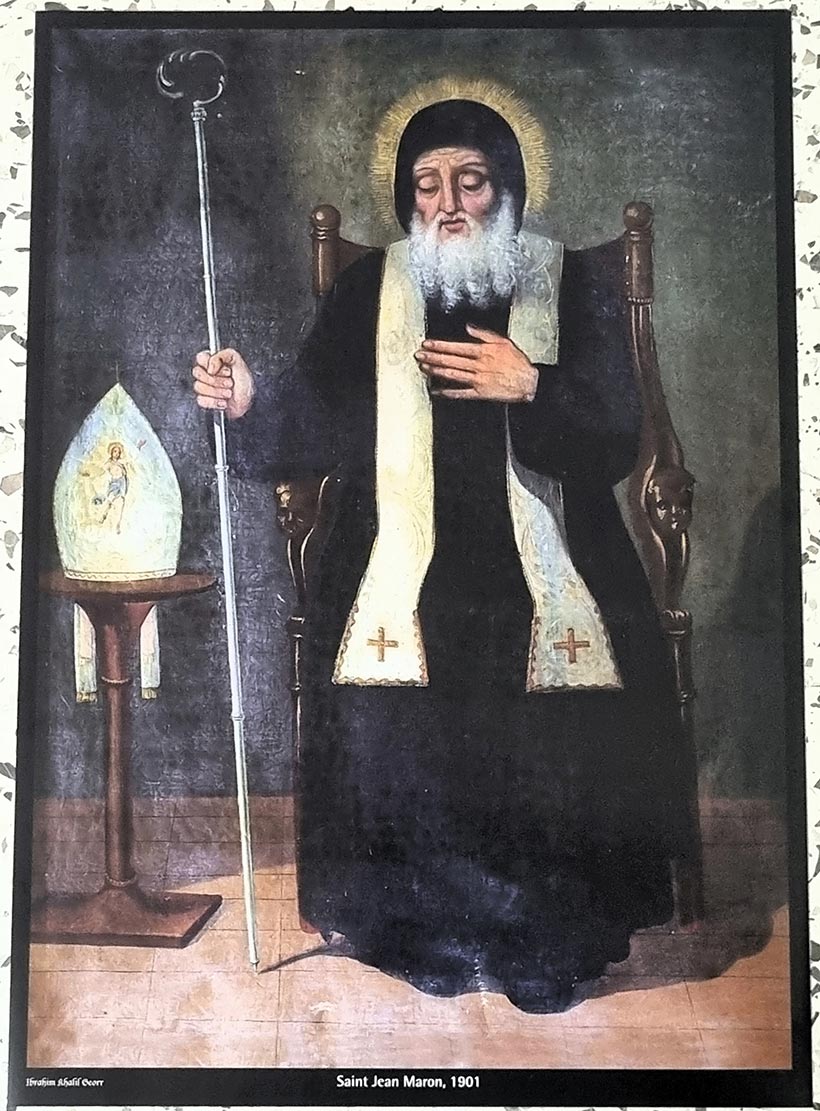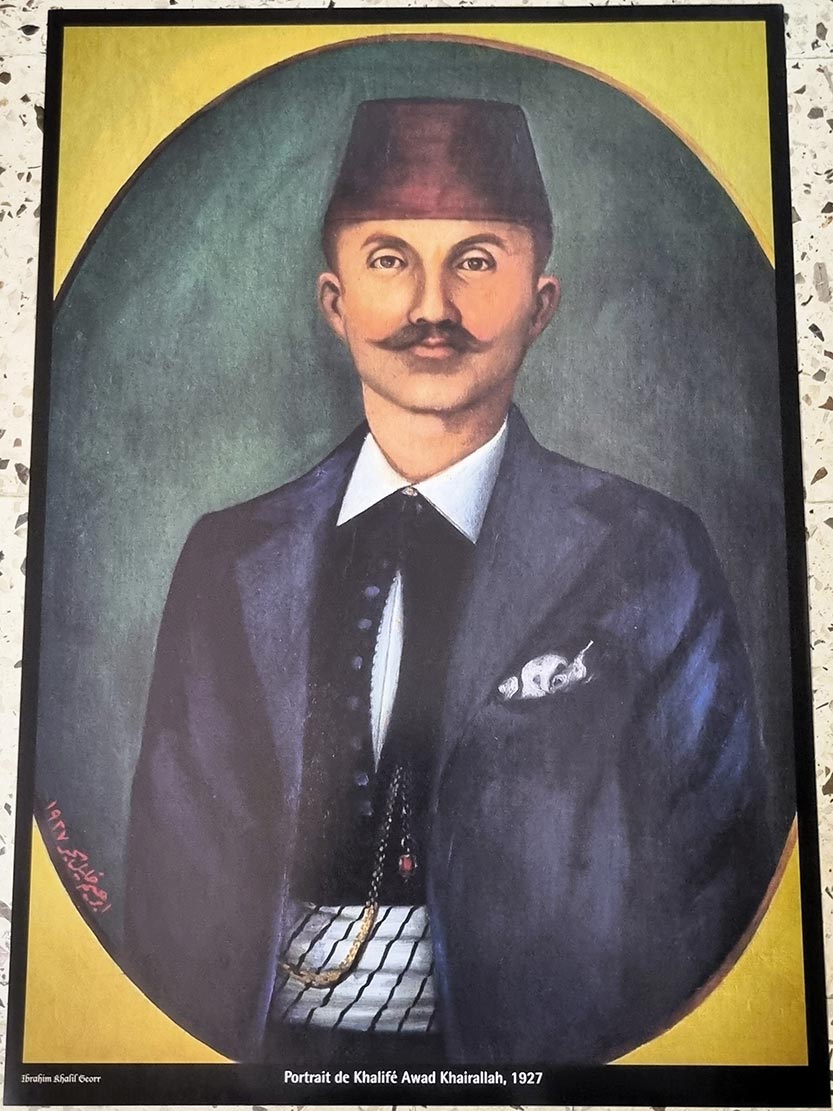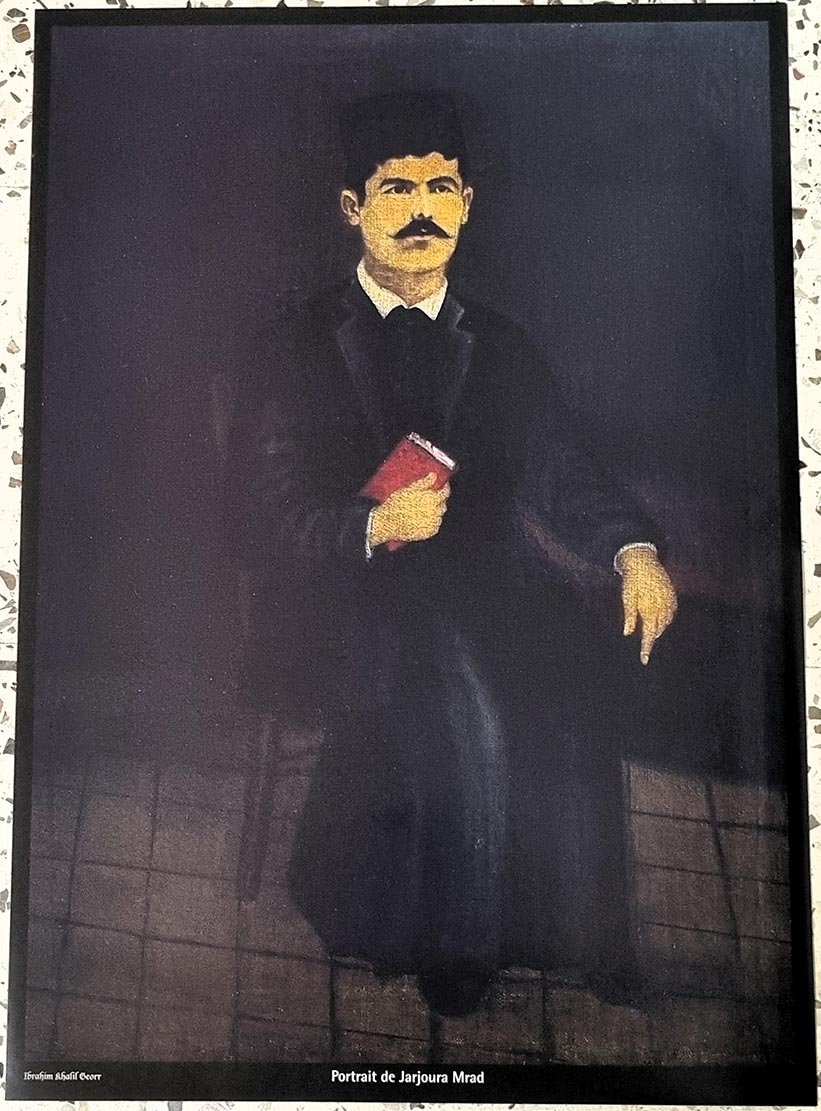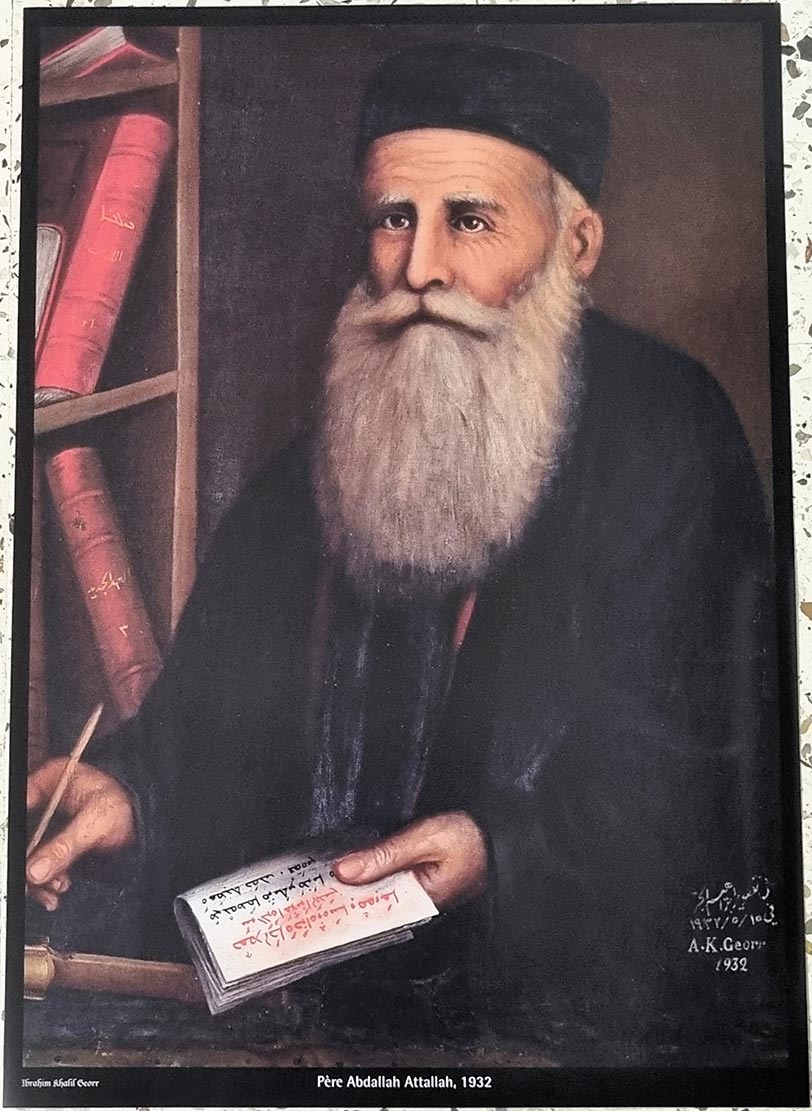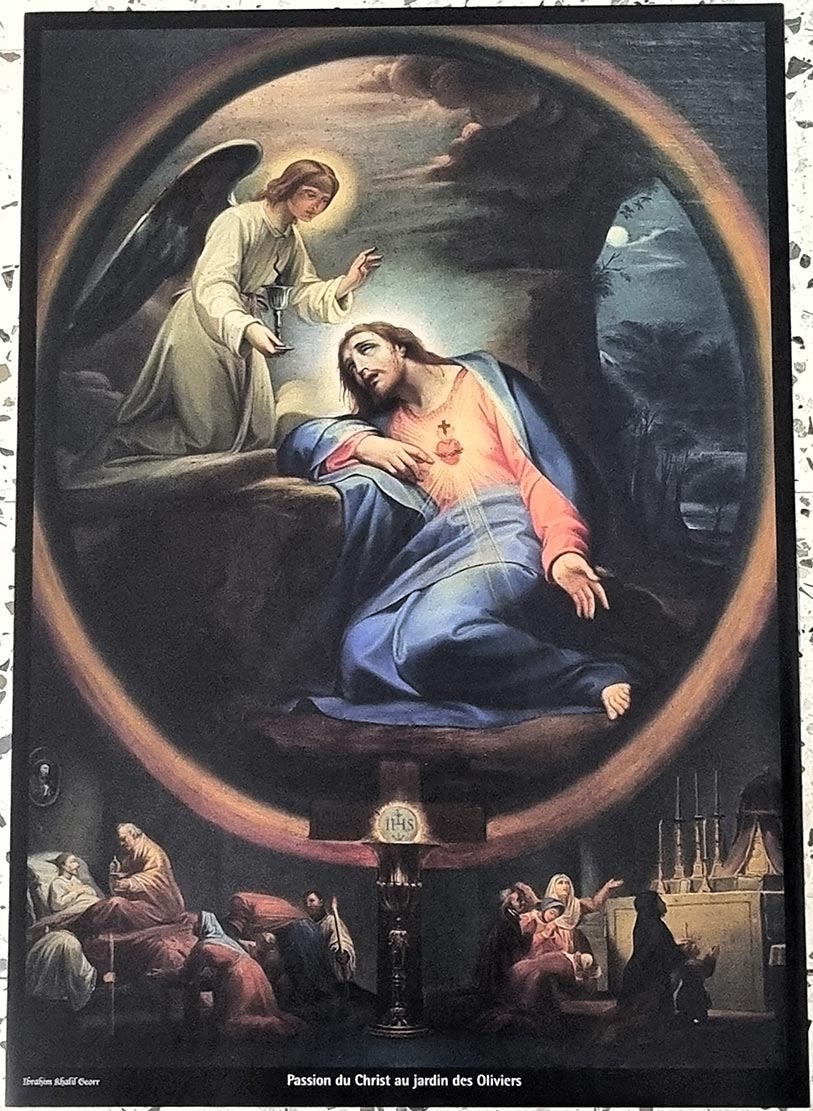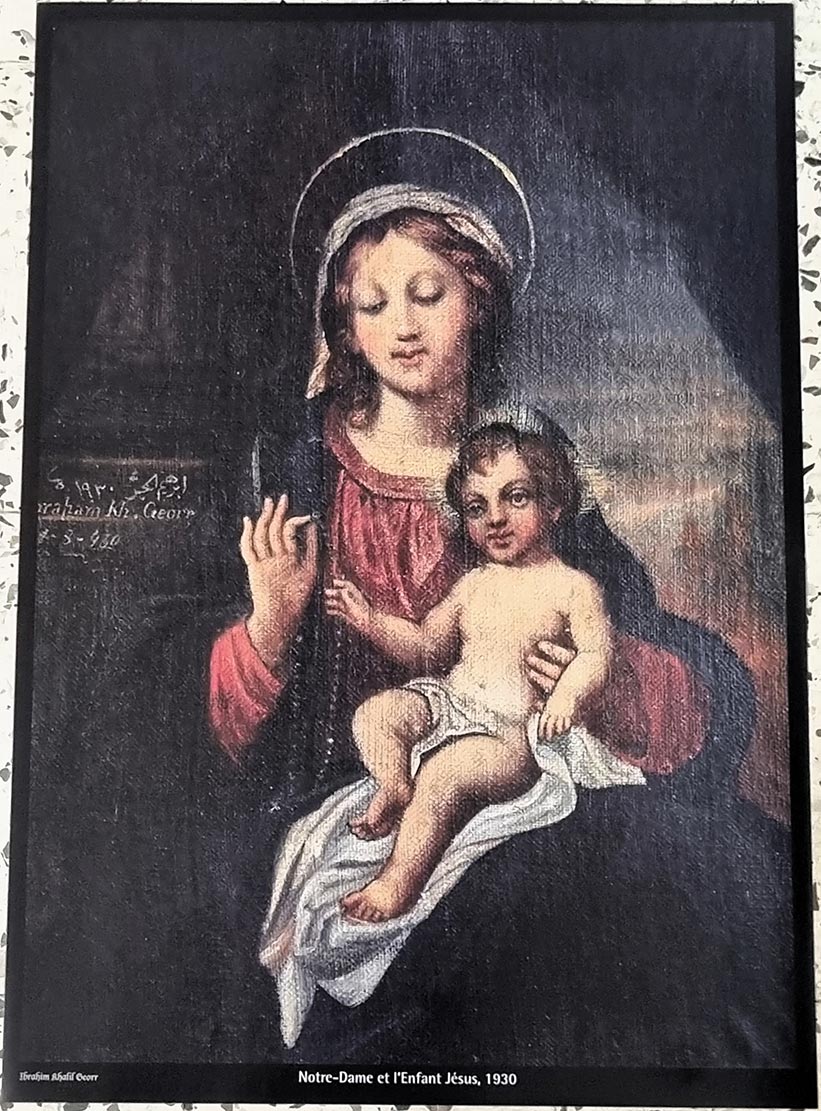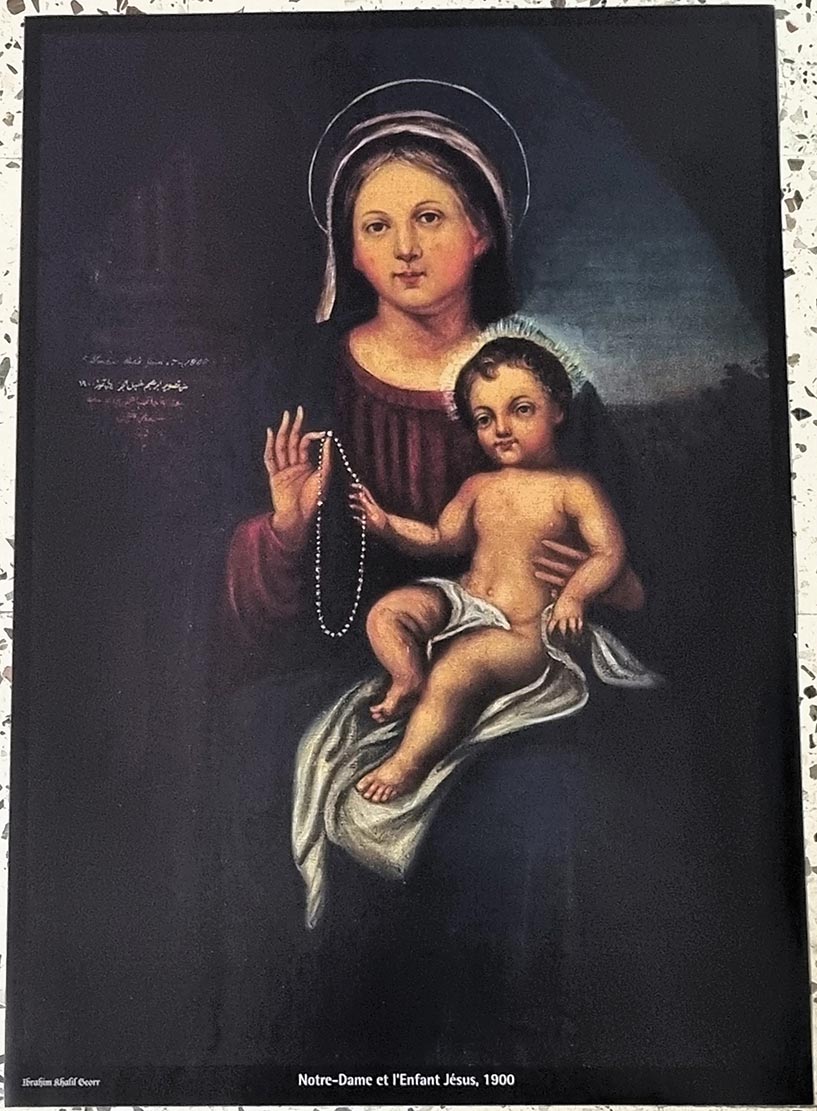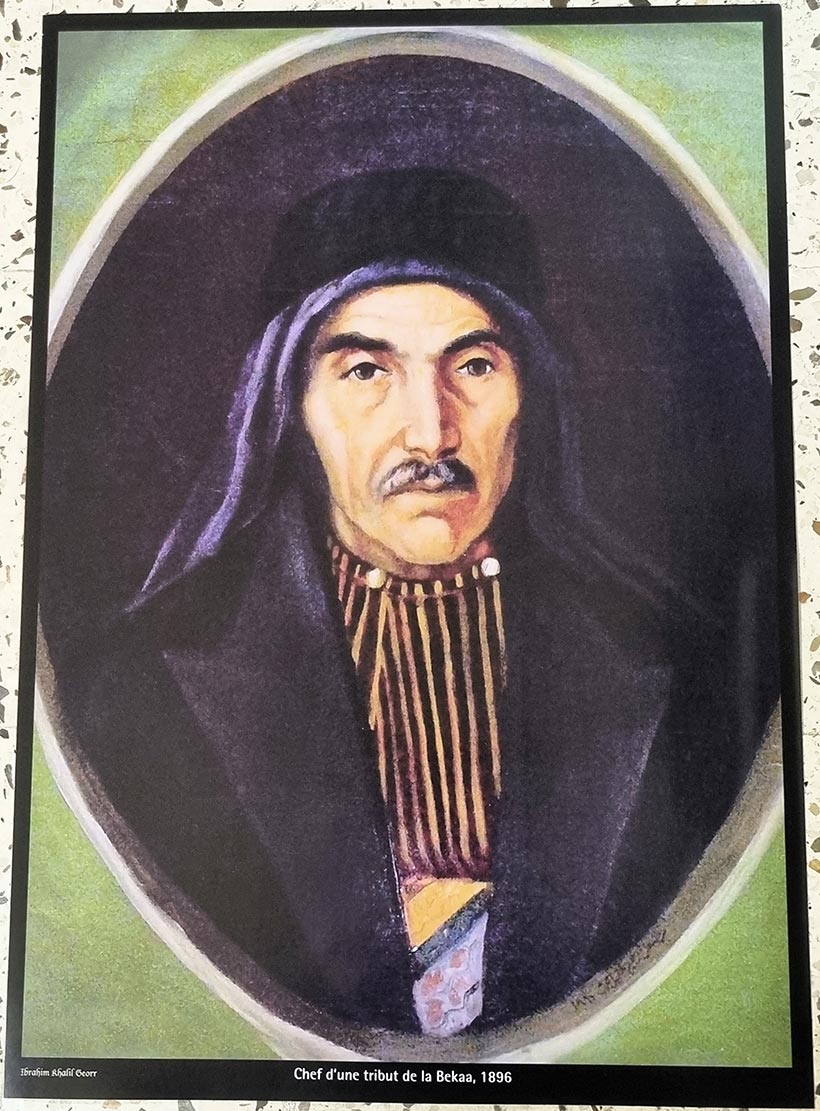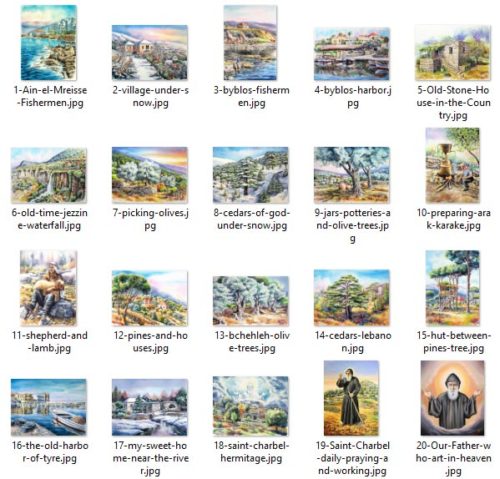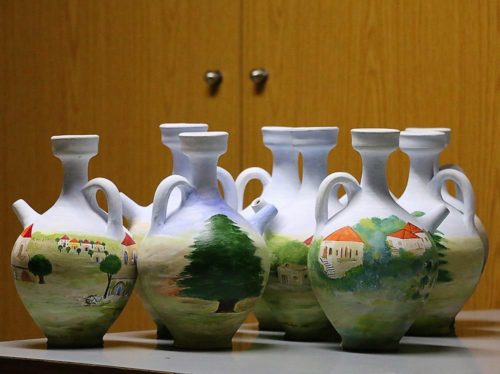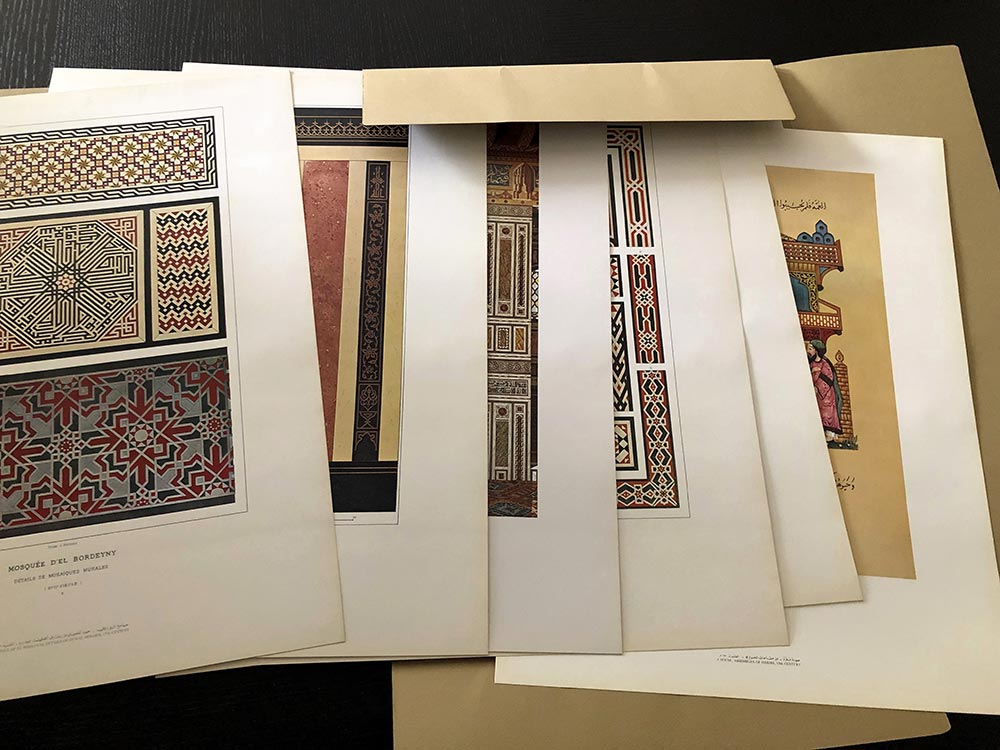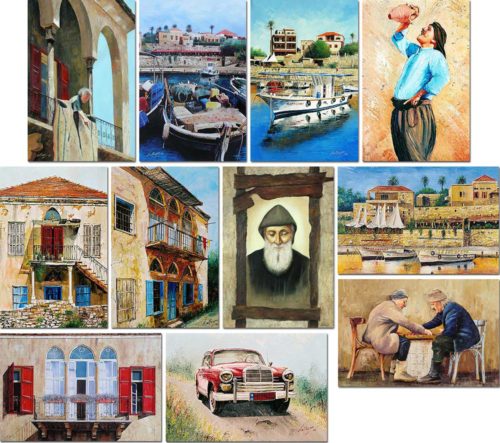Art album of artist painter Ibrahim Khalil Georr (1873 – 1936) with 12 art productions (48×34 cm) and a booklet.
Art Album Ibrahim Khalil Georr
$35.00
Description
LebanonPostcard presents a vintage art album of artist painter Ibrahim Khalil Georr (1873 – 1936). The album contains 12 art productions (48×34 cm) and a booklet.
Sorry for not having clear photos…
I tried a lot to take good photos but it was impossible…
The images are glossy black so it has a little mirror effect…
Chef d’une tribut de la Bekaa – 1896
Notre Dame et l’enfant Jesus – 1900
Notre Dame et l’enfant Jesus – 1930
Passion du Christ au Jardin des Oliviers
Passion du Christ et Mater Dolorosa
Pere Abdallah Attallah – 1932
Portrait de Jarjoura Mrad
Portrait de Khalife Awad Khairallah – 1927
Portrait de l’ecrivain Gerges Zouein – 1896
Portrait Semaan El Khoury Soueid – 1913
Saint Jean Maron – 1901
Saint Maron et deux disciples – 1930
Painter, sculptor and calligrapher, equally versed in medicine as in pharmacology, Ibrahim Georr is the embodiment par excellence of multifaceted and self-taught genius.
Only son of Khalil Georr, he was born in Yahchouch, Ftouh Kesrouan in 1873. Family lore has it that he asked for his bride-to-be’s hand in marriage the very day she was to be wed to another man of her parents’ choosing. Enamored by the advances of this notable man, she interrupted her own nuptials and joined her life to his. They would go on to have 7 children together: Khalil, Daou, Albert, Joseph, Raymond, Michel and Francoise.
Ibrahim Georr received his primary education at Ecole St. Michel in Mradiyeh. Because of childhood illness, he was forced to leave school and depend on what resources he had at hand to complete his education. The pursuit of knowledge would be a lifelong endeavour. He learnt several classical works by heart, mastered Arabic calligraphy by copying from dozens of works and encyclopedias, and learnt physics and medicine in the same way. He engaged in correspondence with several literary and scientific magazines which featured a number of his writings, including “Rules of Arabic Calligraphy.”
“Cheikh Solh” of Yahchouch, played the role of trusted guide, mediator, and medical man to his fellow villagers. He often visited patients in neighbouring villages and even performed numerous surgeries.
During the First World War, when famine ravaged Lebanon and the Ottomans demanded exorbitant taxes when there was nothing left to give the levy to the impoverished villagers; he was able to build a mould to coin money and settled the tax imposed by the Ottomans on his fellow villagers. That was an extremely daring and courageous act. He knew full well that in case he was caught, a death penalty was awaiting him. His village was relieved of all its debts.
Ibrahim Georr is most renowned for his pictorial works. He studied painting in the 1890s under an Orientalist Italian living in Amchit, who was sufficiently impressed by his talents to offer him a scholarship to pursue his studies in Rome. Unfortunately, Ibrahim’s mother categorically refused to have her only son move far away from his native village.
Today, Ibrahim Georr is considered to be one of the precursors of the artistic movement in Lebanon. His works are often displayed in Beirut, as well as overseas; he was featured in the “Lebanese Painting Precursors” exhibit in London in 2002, under the auspices of the British and Lebanese Association.
There are around 75 works to his name scattered around the churches, monasteries and convents of Kesrouan, Jbeil and even the Bekaa. He was an accomplished portraitist and painted several local notables. Several works dedicated to painting in Lebanon pay him due homage.
Ibrahim Georr passed away in 1936.
In French: Peintre, sculpteur, et calligraphe Libanais, ayant également pratiqué la médecine et la pharmacie, Ibrahim Georr incarne l’exemple par excellence du génie autodidacte et polyvalent.
Né à Yahchouch, Ftouh Kesrouan en 1873, il est le fils unique de Khalil Georr. Ses enfants racontent que leur père a demandé leur mère en mariage le jour même où celle-ci s’apprêtait à épouser, à la demande de ses parents (mœurs de l’époque obligent), un homme de Ghouchraya. Fascinée par ce notable sage et respecté dans tout le village, la jeune fille interrompit la cérémonie et s’en alla fonder avec Ibrahim une famille de 7 enfants Khalil, Daou, Albert, Joseph, Raymond, Michel et Françoise.
Ibrahim Georr avait effectué ses études primaires à l’école Saint-Michel de Mradiyeh, un village voisin de Yahchouch. A cause d’une maladie infantile, il dut interrompre sa scolarisation. Il ne put compter que sur ses propres ressources pour compléter son éducation. Une éducation qu’il n’aura de cesse d’étoffer pour finir par connaître par cœur l’Iliade et l’Odyssée ainsi que plusieurs autres livres de référence. Il maîtrisa la calligraphie arabe en recopiant des dizaines d’ouvrages et encyclopédies et apprit la Physique et la Médecine par la même occasion. Il correspondit avec plusieurs revues littéraires et scientifiques qui ont publié certains de ses articles. Il publia les «Règles de la Calligraphie Arabe».
« Cheikh Solh » de Yahchouch, il a longtemps constitué un recours pour les villageois en mal de conseils avisés et des remèdes de sa pharmacie. Il se déplaçait souvent dans les villages voisins pour examiner des patients et même pratiquer des opérations chirurgicales dans une région où sa polyvalence et son érudition faisaient référence.
Durant la guerre 1914-1918, quand la famine frappait et que l’occupant ottoman venait réclamer la « mireh » aux villageois affaiblis, il a sculpté deux moules lui permettant de frapper le Ryal Hamidi, et paya les impôts dus à l’Empire ottoman par son village.
Mais Ibrahim Georr est surtout connu pour son œuvre picturale. Il étudia la peinture auprès d’un peintre orientaliste italien vivant à Amchit dans les années 1890. Impressionné par ses facultés et son talent, celui-ci lui proposa une bourse d’études à Rome. Sa mère, qui ne voulait pas perdre » son fils unique, s’y opposa catégoriquement.
Aujourd’hui, il est considéré comme un des précurseurs du mouvement artistique au Liban. Souvent exposé à Beyrouth, il a participé à l’Exposition des peintres libanais “Précurseurs” à Londres en 2002, sous les hospices de la “British and Lebanese Association”.
Il a à son actif environ 75 œuvres éparpillées dans les églises, monastères et couvents du Kesrouan, de Jbeil mais aussi au Batroun et même dans la Bekaa. Il a également peint les portraits de nombreux notables locaux. Plusieurs ouvrages dédiés à la peinture libanaise lui rendent hommage.
Il décéda en 1936.
هو إبراهيم خليل الجرّ، من مواليد قرية لبنانية صغيرة (يحشوش)، في فتوح كسروان، عاش حياته كلها حتى وفاته في تلك القرية التي لازمها باستمرار.
من طرائف حياته أنه تقدم بطلب يد زوجته ماري في يوم زفافها من شخص آخر إختاره والدها، ولكنها تجاوبت مع مبادرته فضمها رباط زوجي نتج عنه حياةً رغيدة وأولاد سبعة : خليل، ضو، ألبير، ريمون، جوزيف ميشال وفرنسواز.
هذا الرجل الذي برع في الرسم والنحت والخط، وعلّم نفسه الطب والجراحة واستطاع أن يصلّ عملةً دفع بموجبها المستحقات الضريبية على قريته أيام المجاعة والجور العثماني خلال الحرب العالمية الأولى هذا الرجل لم يتلق من التعليم الرسمي إلا قليله في مدرسة مار ميخائيل القريبة من قريته. ولأنه كان دائم التوعك في صغره، حضنته أمه بشعور قوي من اللهفة حال دون ابتعاده الى أي مكان آخر طلباً للعلم. وحتى حين إحتضنه رسام إيطالي في عمشيت وعرض عليه منحة لدراسة الفن في روما، لما توسّمه فيه من قدرة موهبيّه، حالت عاطفة الأم وخوفها عليه بينه و بين فرصة العمر.
وإلى جانب براعته في الفنون على أشكالها، كان إبراهيم الجرّ موسوعياً في تمكّنه من ممارسة التعليم الذاتي الذي أوصله إلى إلياذة هو مروس وأعمال كلاسيكية أُخر، كما مكنه من الدخول طرفاً مقتدراً في حوارات مع آخرين على صفحات المجلات العلمية والأدبية في زمانه في شؤون اللغة والصرف والنحو وحتى علم الفلك والفضائيات.
ولعل أكثر ما يُذكر به اليوم هو لوحاته المنتشره في الكنائس والأديره والبيوت على إمتداد لبنان والتي عُرضت مرات عدة في معارض طليعيّة في لبنان وبريطانيا وسائر أوروبا.
إنه يُعتبر بحق واحداً من روّاد فن الرسم في لبنان، بما له من لوحات يفوق عددها الخمسة والسبعين لوحة ولعلّ المعرض الذي أقيم في بريطانيا سنة ۲۰۰۲ بمبادرة من الجمعية البريطانية اللبنانية British Lebanese Association هو خير مثال على ما إتصف به هذا المبدع في عالم الرسم.
إبراهيم خليل الجرّ يُمثل قوة الموهبة وإرادة التعلم الذاتي التي إنتصرت على محدودية بيئة القرية وإمتدّت إلى الأفق الرحيب إبداعاً وريادة وخلوداً.
توفي في جبيل عام ١٩٣٦.
LebanonPostcard will be responsible for sending the album you order, through a fast courier with a tracking number, guaranteeing reception of the package. The item may take two to five days to arrive, according to the country it is sent to.
Additional information
| Weight | 2.0 kg |
|---|---|
| Dimensions | 1 × 1 × 1 cm |


